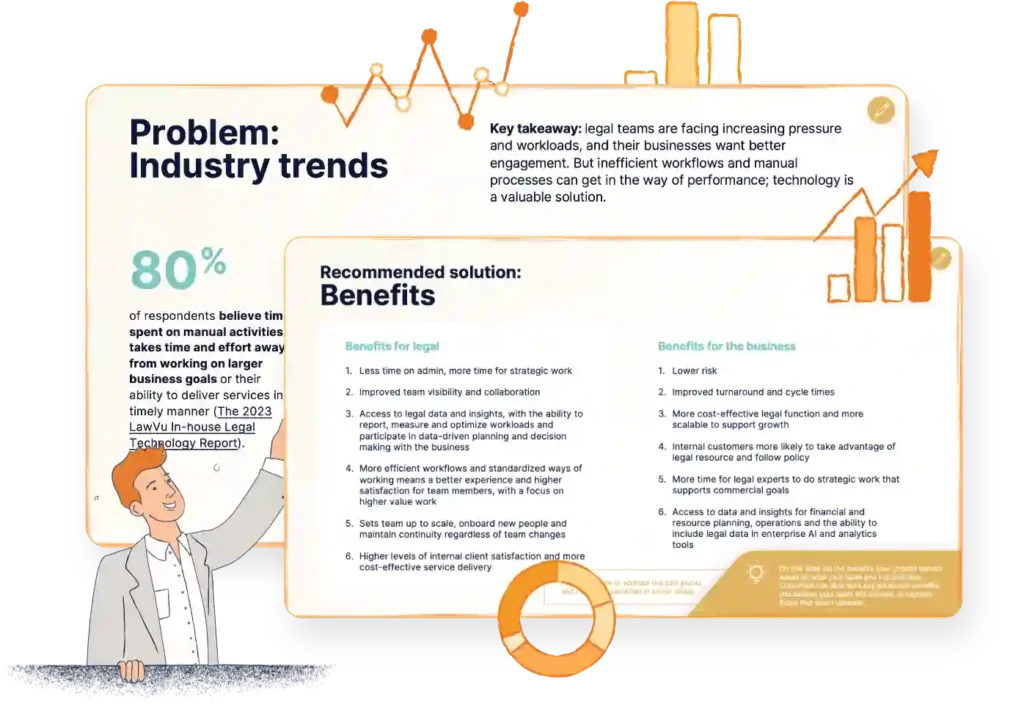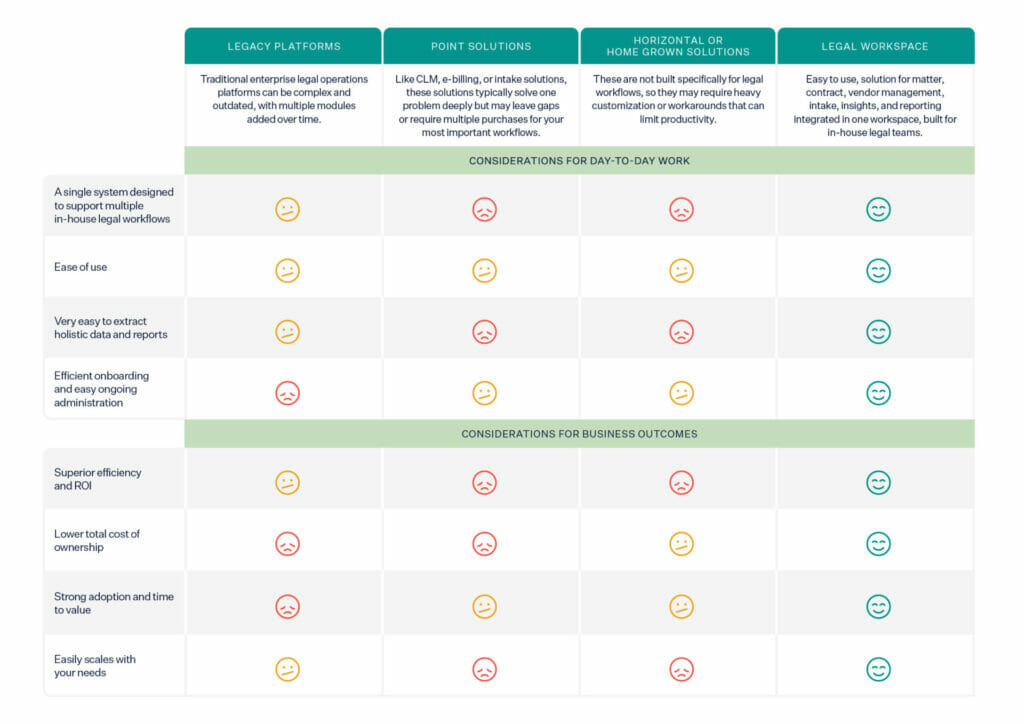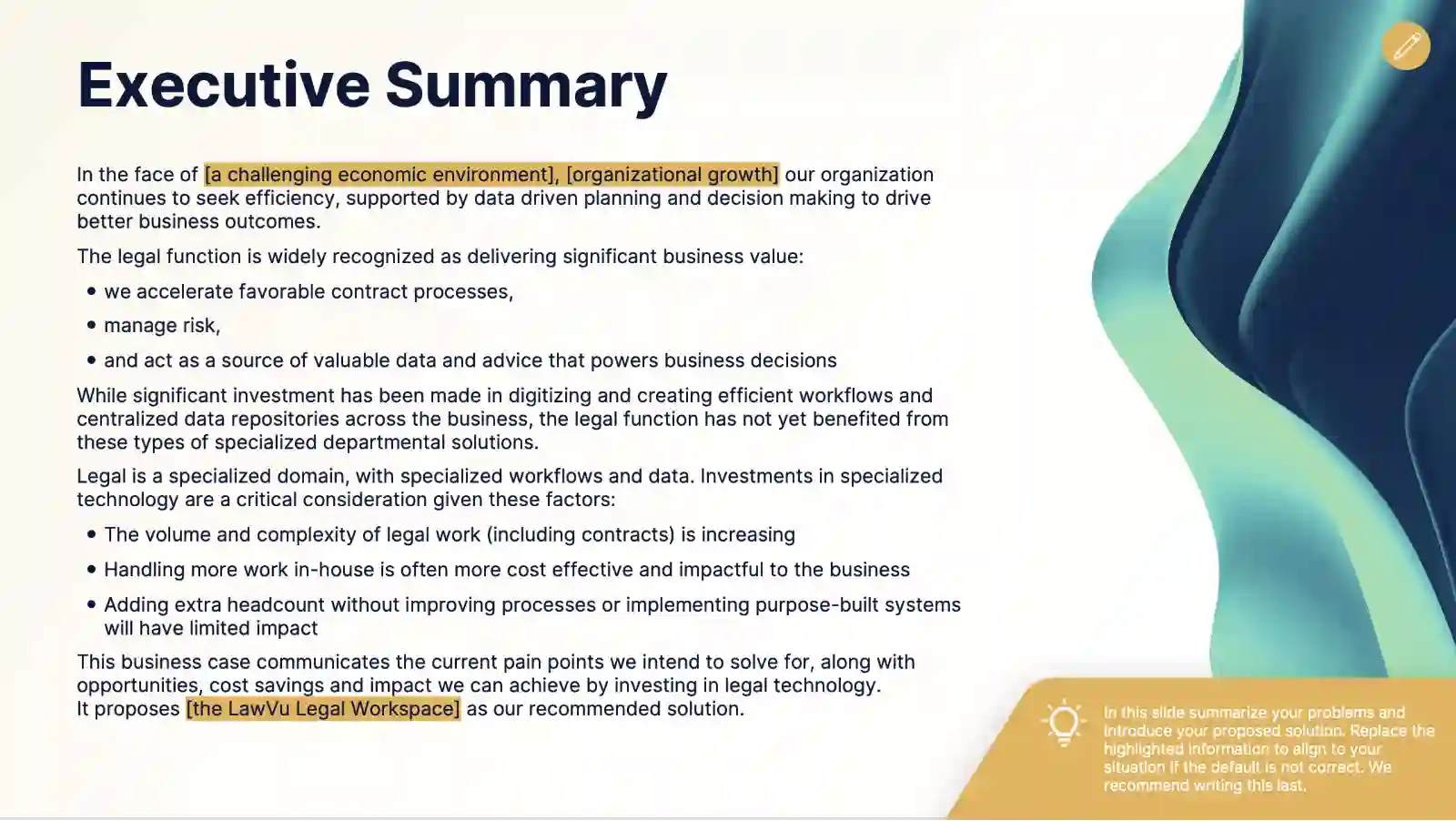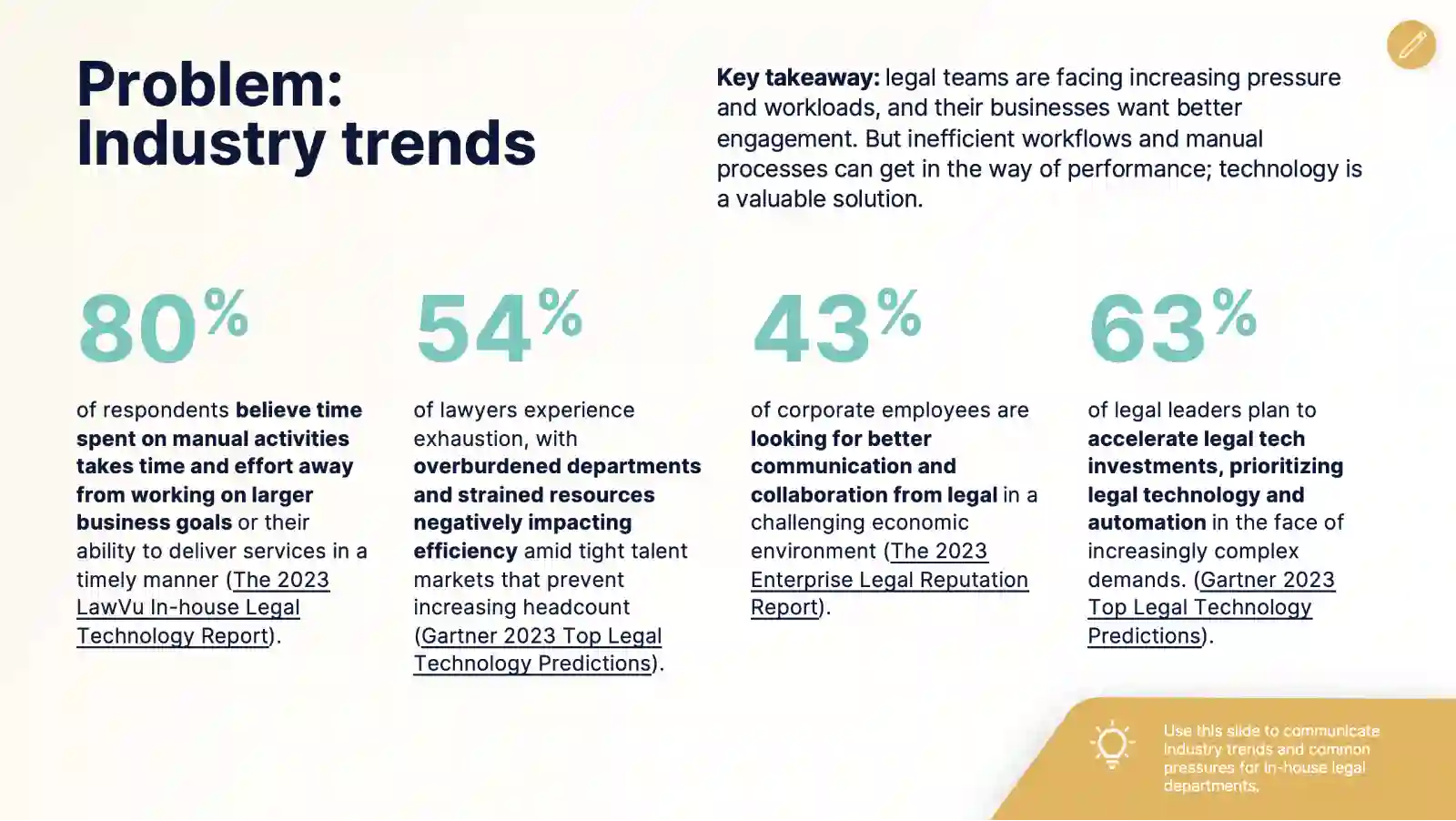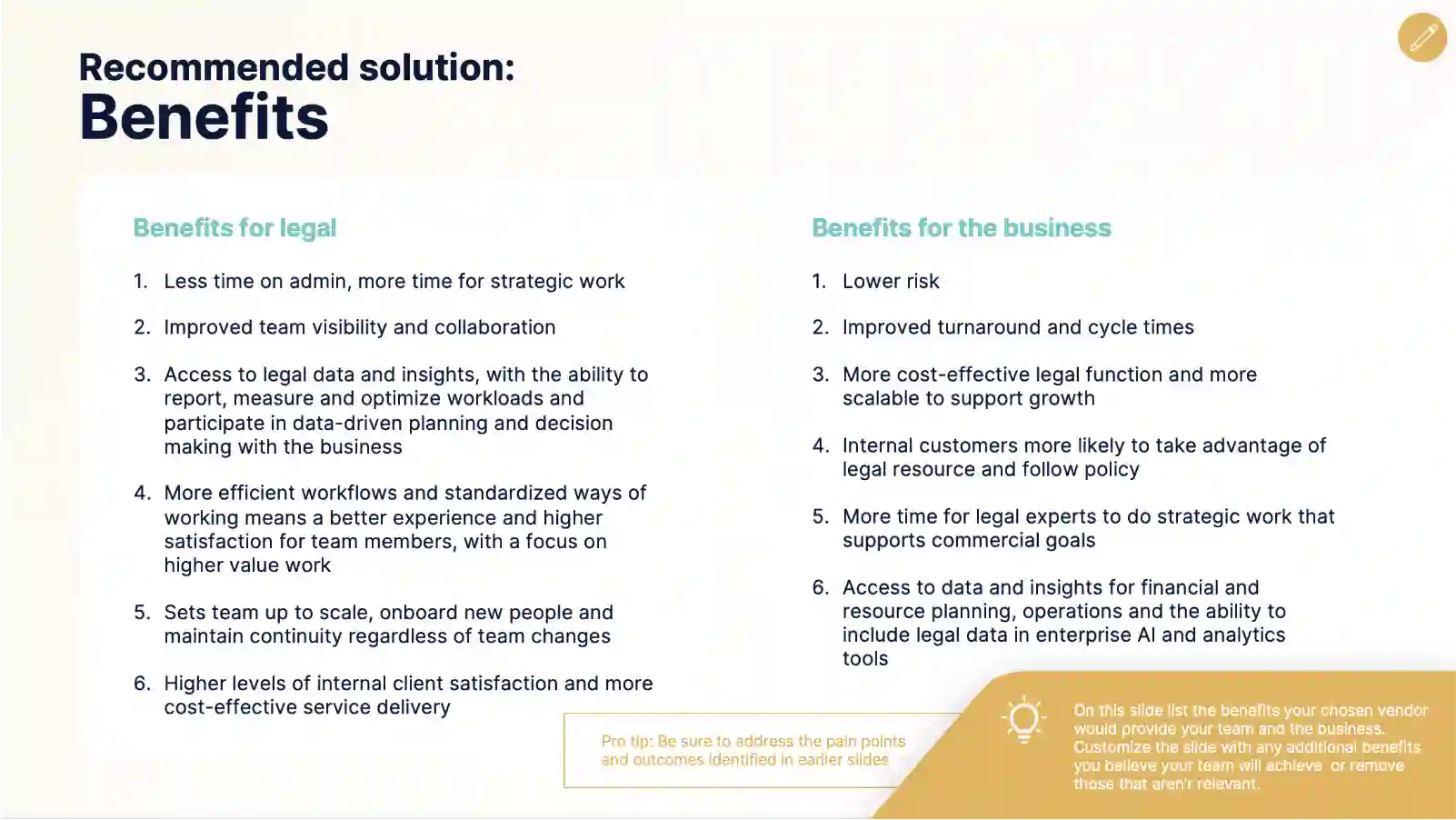The more time spent without in-house legal software, the greater the cost
Legal teams turn to in-house legal software to solve a litany of problems including, but not limited to, saving valuable time for legal team members, creating visibility and continuity with a central repository for legal work, automating and streamlining workflows across the business, speeding up cycle times, reducing risk, scaling legal service, managing costs, creating data sets for better decision making… the list goes on.
However, the prospect of purchasing new in-house legal tech can be daunting: the number and type of solutions available is vast and varied and can be hard to make sense of; many in-house legal teams are pressed for time and resource, making it difficult to find time to evaluate technology solutions; budget pressures and resource constraints across the board can make it difficult to procure budget or feel confident about the return on investment. But the more time you spend without the right legal technology, the more it costs the business:
+
$
How to use this guide
This guide is intended to support you in making buying decisions for in-house legal software best suited to your legal function and the wider business. In doing so, it may not make sense to follow each step sequentially, and that’s ok! The important thing is that these considerations are taken on board as and when you encounter them.
We’ve made sure to include useful tips and resources throughout each step as you progress.
The ultimate goal is for the buying process to move at pace, so you're quickly able to focus on delivering stellar service to the business without it costing your legal function (and business) any more time or money than necessary.
Let’s dive in!
Step one: Identify challenges and opportunities within your legal function
Crucial to evaluating legal tech solutions quickly and effectively is clearly identifying your current situation, the pain points and challenges that need solving within your in-house legal team.
it’s recommended that you ideate the various ways in which the prospect of new legal technology will address problems for both legal and the business, and express expected outcomes in ways that align with business goals; this will help you to secure funding and support later on and should become part of your business case.
To do this, start by capturing problems, opportunities, and potential outcomes in a format that is both easy to share and interpret. This will make it easier to express the pain points and potential benefits of legal tech to both legal and the business, and to engage stakeholders to get agreement on your investment.
Here’s an example from our free business case template of how you could identify and present this:
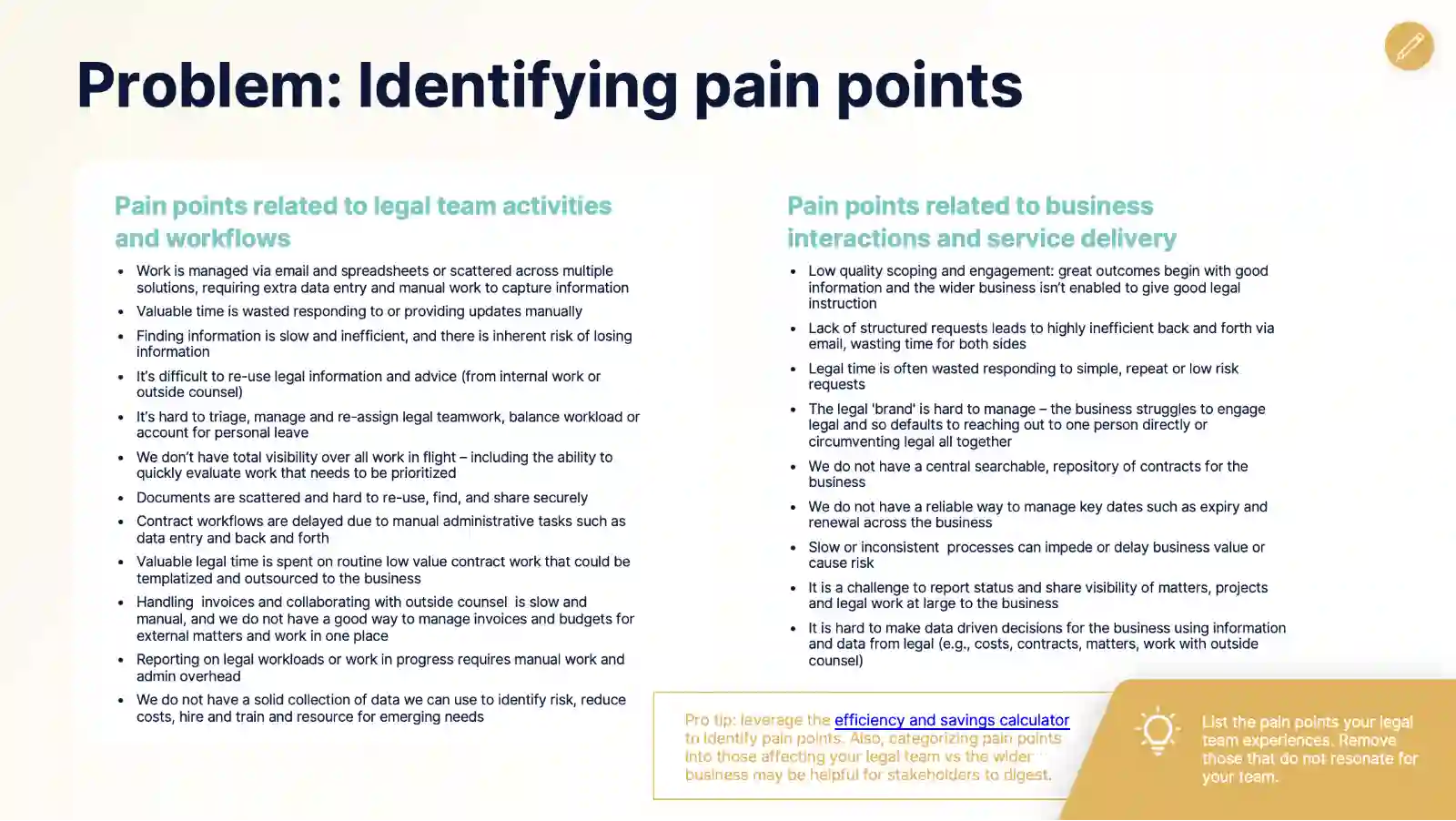
Step two: Identify stakeholders and launch your legal tech buying team
Who supports your selection and rollout process? Are you clear on the requirements for securing budget for legal tech if it’s not already approved?
To move at pace with securing new legal tech and to avoid as many roadblocks as possible, you need to know which stakeholders to engage, including those that can help accelerate the process, those that may slow it down, and the specifics each stakeholder is most invested in.
Here are a few stakeholders we think you should consider:
- Security/ IT
The good news is that many legal tech SaaS vendors have low IT requirements, so you can counter any internal pushback by supplying the IT team with a clear picture of their involvement (or lack thereof). However, you may require sign-off on a security plan, or IT support with implementation and integrations. That’s why it’s best to know what this team will require from you and your new legal tech vendor up front.
- Leadership
Getting support from leadership is essential, especially if you do not have budget, as the CFO or similar stakeholders are not likely to allocate technology budget without realizing its importance for legal innovation. Which means it is up to legal to advocate for it. And even if you do have budget allocation for legal tech, it’s a good idea to engage with leadership for their buy-in - this supports a successful rollout across the business.
Tip
Understand what your stakeholders require and regularly update them along the way. But be careful not to work your schedule around them as this can slow your buying process. This free business case template will help you to successfully engage with multiple stakeholders.
Next, it’s time to select your legal tech buying team - and the smaller the team, the faster you will be able to move through the buying process.
In your buying team, consider allocating:
- A project lead
The project lead moves things forward, captures critical requirements, communicates with vendors, and is responsible for communicating to your broader group of stakeholders.
- A subject matter expert(s)
Subject matter experts are highly interested in sourcing the right legal tech solution and should be present for all demos and product evaluations. They are likely to be your internal champions when it comes to implementing your chosen legal tech solution.
- An executive sponsor
An executive sponsor is ultimately the decision maker and is accountable for making the project happen. Often, this is the General Counsel or Chief Legal Officer, but in some organizations you might engage the Chief Technology Officer or Chief Executive Officer.
- A business representative(s)
Engaging with a representative who will be a high-frequency business user or stakeholder outside of legal is recommended, as their adoption will be critical to the success of the solution, especially if you are considering a matter management, intake, CLM, or contract automation solution.
Tip
Step three: Identifying key requirements and legal tech capabilities
As you identify and evaluate pain points and challenges, your legal tech buying team will need to consider key vendor requirements and capabilities. These become part of the requirements for your selection process.
Doing this step correctly will also go a long way in saving you time (and money) by ensuring that you are meeting with the best-suited legal tech vendors and can make sound evaluations, ultimately leading to a successful outcome.
Typically, legal tech capabilities include:
- The ability to seamlessly address multiple pain points and workflows (such as contracts and matters, spend management and e-billing, and insights and reporting) from a single source of truth or system
- Contract automation
- Document and knowledge management
- Configurability of matter fields and legal request (intake) forms
- An intake portal that enables the wider business to self-serve, access information and engage the legal team directly
- Analytics and reporting capability
- AI capabilities such as extracting important contract clauses and key data from invoices
As well as these key requirements or capabilities, there are some non-functional requirements that are equally as important, such as: ease of use, onboarding, implementation and adoption, and service and support. We’ll dive a little deeper into those requirements in the next section.
Tip
- Identify 3-6 critical use cases or workflows for your legal team. Key capabilities will become clearer from this exercise and pairing these along with the identified pain points and challenges will help you prioritize key requirements and prepare for product demonstrations down the track.
- At this stage of the legal tech buying process, it’s a great time to create an RFP (request for proposal) or RFI (request for information) if you need one. Start by clearly documenting the key criteria and capabilities you’ve identified - and keep it simple. This can be shared with potential vendors or used to guide decision making and evaluations as your team progresses through the buying process.
Step four: Evaluating legal tech solutions
When it comes to legal technology, the marketplace is inundated with solutions - which can easily be overwhelming. But if you’ve outlined your primary challenges and pain points well, and you’ve identified your key requirements and capabilities, you can now hone in on and evaluate the vendors that will best serve your legal function and wider organization.
A good place to start is to get a general understanding of the marketplace. In short, there are a few common categories of legal tech solutions available:
- Point solutions (like CLM and e-billing tools)
- Traditional ELMs
- An integrated legal workspace
- Vertical solutions
Tip
Another element in narrowing your selection criteria involves placing emphasis on the considerations that are likely to impact successful implementation and addressing any concerns stakeholders may have. For example:
- Ease of use, the onboarding process, modern SaaS architecture, low overhead for IT. These ensure you can get value quickly without draining your business resource
- Helpful self-assist resources or learning academies to help you get the most out of the system
- Security requirements: a non-negotiable requirement that can be time consuming, so only engage with vendors who are able to provide strong security packs from the outset
- Scalability, ROI, and total cost of ownership considerations: these will matter to stakeholders representing the wider business and ensure you’re a good steward of legal resources
Tip
Security assessments often slow things down! Make sure you know what is required for security assessments and the stakeholders involved. Any legal tech vendors worth engaging with will be able to provide a security pack you can pass on for review before spending time on demos.
It’s also a great time to take advantage of resources such as customer case studies representing organizations similar to yours and review sites such as G2 and Gartner Peer Reviews. Collectively, these resources can also help to narrow your selection criteria and evaluation of the legal tech vendors under consideration.
Step five: Meeting legal tech vendors and product demonstrations
Product demonstrations by legal tech vendors play a crucial role in showcasing how a solution can address your key priorities (or not).
However, investing extensive hours in product demonstrations and meeting with various legal tech vendors can be time-consuming.
How to prepare for upcoming product demonstrations:
- Invite individuals who will be making most use of the software so they can evaluate how the solution works for them. These people may not be part of your immediate legal tech buying team, but their input is crucial
- Ask the legal tech vendor for an agenda of what will be covered in the product demonstration and if necessary specify what you would like the vendor to address or showcase as part of their demonstration
- Send your questions before the demonstration. This ensures that your most pressing questions are answered during the presentation or that information is shared beforehand. This can save valuable in-person time
- Remember to consider non-functional capabilities and requirements. Ask these questions:
- Support: How will the vendor provide long-term support after implementation?
- Training: How will the vendor provide training, and how accessible is it to users? How to onboard new users?
- Implementation: What does the implementation process look like? How long will it take?
- Ongoing maintenance and admin: Do you need IT to get involved?
- Scalability and pricing: Can the solution be easily configured to meet your needs? How easy is it to add functionalities and scale when your team or business grows? What happens with pricing if this is the case?
What happens after the product demonstration?
Following the product demonstration, you’ll want to keep the ball rolling or risk the buying process stalling, or you might forget important details. That’s why it’s a good idea to round up your legal tech buying team and run a quick follow-up session to discuss the pros and cons of the solution while the demonstration is still fresh.
For those stakeholders unable to attend the demonstration, share a brief summary identifying key pros and cons as well as the overall evaluation - whether or not it’s worth progressing through the legal tech buying process.
As you meet with each legal tech vendor whose demonstrations met your key requirements and selection criteria, be sure to create a simple and mutual action plan. This should outline next steps for both your team and the vendor. Special attention should be given to any key steps required for final sign-off, such as contract reviews, as this can often slow the buying process.
And, of course, for those vendors who fail to meet your requirements and key selection criteria, inform them and swiftly move on with the others.
Tip
Step six: Make your business case for legal tech
At this stage, you will most likely have one or two legal tech vendors who stand out, but you may still be in the final evaluation stages or need to seek sign-off from certain stakeholders.
If you already have sign-off (great work!), it's time to engage key stakeholders and business partners as you embark on the final steps to purchasing your selected legal tech, most especially with implementation and onboarding impending.
To help gain sign-off and to bring clarity to the next stage of the buying process, a compelling business case is key! You’ll now have an even clearer picture of how your chosen legal tech vendor supports your selection criteria along with key requirements and capabilities, so it’s time to build (or further refine) your business case.
Fortunately, LawVu’s business case template is free to access and fully customizable, so you can tailor it to the unique needs of your legal function and business as well as showcase both qualitative and quantitative evaluations.
Tip
While anecdotal and qualitative information is useful in a business case, it’s always a good idea to include data, metrics, or statistics where you can. For example:
Relevant industry reports such as The 2024 In-house Legal Technology Report showcases trends and common pain points such as inefficiencies affecting in-house legal teams, which can help make a clear case for investment in in-house legal technology.
Tools such as the legal efficiency and savings calculator can help quantify the time and money spent on manual administrative tasks based on industry studies or your own data.
Include case studies and ROI or success metrics in your business case. Your preferred vendor legal tech vendor should be able to provide these.
- Remember to include expected business outcomes in your business case. Your preferred legal tech vendor should be able to provide an executive summary, ROI summaries, outcome statements, or other helpful documentation that can be shared with your key stakeholders.
- Ask your chosen vendor for implementation guides or similar materials as you’ll want to get started as soon as you get the green light. You can share this information with your legal team to drive adoption and excitement. You’ll also want to identify an implementation team and time frame.
Hopefully, we’ve helped dispel your concerns surrounding the prospect of the legal tech buying journey and have provided you with a clear path forward. Remember, the ultimate goal is to choose the right legal tech for your legal function (and the wider business) and for the buying process to move with pace, as each day you delay is costing your legal function (and business) time (and money).
In no time, you will have influenced key stakeholders with your business case as to why investing in the correct legal tech solution will solve inefficiencies for your team, and your dedicated legal tech buying team will be well on track with implementing your new solution.
